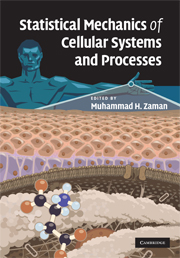Book contents
- Frontmatter
- Contents
- List of contributors
- Preface
- 1 Concentration and crowding effects on protein stability from a coarse-grained model
- 2 Observations on the mechanics of a molecular bond under force
- 3 Statistical thermodynamics of cell–matrix interactions
- 4 Potential landscape theory of cellular networks
- 5 Modeling gene regulatory networks for cell fate specification
- 6 Structural and dynamical properties of cellular and regulatory networks
- 7 Statistical mechanics of the immune response to vaccines
- Index
- Plate section
7 - Statistical mechanics of the immune response to vaccines
Published online by Cambridge University Press: 04 September 2009
- Frontmatter
- Contents
- List of contributors
- Preface
- 1 Concentration and crowding effects on protein stability from a coarse-grained model
- 2 Observations on the mechanics of a molecular bond under force
- 3 Statistical thermodynamics of cell–matrix interactions
- 4 Potential landscape theory of cellular networks
- 5 Modeling gene regulatory networks for cell fate specification
- 6 Structural and dynamical properties of cellular and regulatory networks
- 7 Statistical mechanics of the immune response to vaccines
- Index
- Plate section
Summary
Introduction
The immune system provides a biological example of a random, disordered, and evolving system. A faithful model of the immune system must capture several unique biological features. First, the antibodies of the immune system each contain many amino acids with many interactions among them, yet the amino acids are of 20 types. Second, each person has only a finite number of antibodies, out of a nearly infinite space of possible antibodies. Third, dynamics is important, because diseases must be cleared from an infected person via the immune system relatively rapidly. Fourth, there are correlations between the immune system and the pathogen, because diseases evolve in response to immune system pressure. Due to these four technical features, it is natural to use statistical mechanics to build quantitative models of the immune system, in an effort to understand the response of the immune system to pathogens and to optimize this response via vaccine design.
Although a significant number of detailed experiments have been performed on the immune system, it is far from completely understood. New scientific discoveries can have significant impacts on public health, as many diseases remain banes to mankind. For example, the worldwide mortality from influenza epidemics is 250 000 to 500 000 people annually, with 5% to 15% of the world's population becoming ill each year [1].
- Type
- Chapter
- Information
- Statistical Mechanics of Cellular Systems and Processes , pp. 177 - 213Publisher: Cambridge University PressPrint publication year: 2009
- 3
- Cited by



